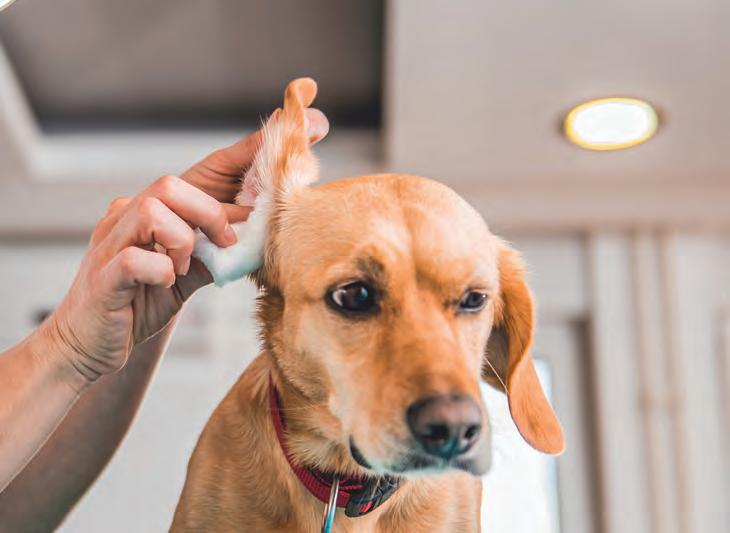
7 minute read
Otitis [Ear Infections!] in Dogs & Cats
By Lillian M. Roberts, DVM Country Club Animal Clinic
Ear inflammation and infections are a common and often frustrating condition in pets. Because of the conformation (i.e., design) of the typical quadruped ear canal, infections are not always apparent until they are quite advanced.
Advertisement
Otitis is the medical term used to describe ear infections—although to get technical, the term actually refers to inflammation. The difference between infection and inflammation is the crux of how the condition develops. But, for practical reasons, the two terms are used interchangeably. The type we see most often is called otitis externa—infection of the ear canal.
Almost all cases of otitis have an underlying cause—the thing that triggers inflammation. In most cases, this is an allergy to something in the animal’s environment or its food. Just as allergens cause our eyes to water and our sinuses to swell and itch, they cause dogs’ (and cats’) ears to itch. And just as humans can develop sinus infections as a result of chronic inflammation, so can dogs’ ears become infected if the underlying allergy lasts a long time and isn’t treated.
Wow, that sounds easy, right? Just treat the allergies and no more infection! If only it were that simple. Allergy treatment is a multi-billion-dollar industry in humans for good reason. The good news is, humans suffering from chronic allergies have led to a lot of money being spent on developing treatments—and many of those dollars spill over or go through initial testing in dogs.
The bad news is, while we have learned a lot about the causes—and treatments—of otitis in pets, they can still be very difficult to eliminate.
Let’s take a look at how otitis develops. First, we have inflammation due to allergy, chronic wet/dry cycles in the ears from swimming, the presence of an irritant such as a foxtail, or even overzealous cleaning (or some combination of these). Anatomy works against the pet here—otitis is more common in dogs with ear flaps that hang down, reducing air circulation that helps dry and aerate the canal. Excess hair that protects the healthy ear against invading pathogens and foreign objects works against us when the ear becomes inflamed and increased secretions gum up the works.
The lining of the ear is modified skin closely connected to cartilage. Cartilage doesn’t “swell” because it’s considered “hard tissue”—basically holding its shape while the lining thickens and changes. These changes alter the normal defenses— basically the “immune system” of the ear is suppressed. The surface becomes reddened and cells that secrete protective compounds, such as ceramides and wax, are either stimulated or suppressed, resulting in an ear that can’t defend itself.
The lining of the ear, like the skin, is basically covered with bacteria and a few yeast. These don’t cause problems most of the time—they simply live in harmony with their environment. But add a little heat, constant moisture, and a dark environment with minimal air flow, and you’ve basically created an incubator. Microbes take advantage, multiplying and thriving. This triggers an even more exaggerated inflammatory response, which further benefits the microbes, and it’s “Off to the races!”

Normal ears secrete a small amount of wax, but irritated ears can really work overtime, producing increased amounts of wax, serum, and even blood or pus, depending on other factors. This material accumulates in the ear canal—a tube that is about seven times longer than our own ear canal and shaped roughly like an “L.” Gravity works against the pet, and the hair that naturally lines the canal becomes wet and gooey, clogging up the tube. This causes pain, of course, and often a bad odor. But even the odor is held back by the floppy, hair-covered ears.
These are all reasons why ear infections can get so bad before the pet’s owner is even aware there is a problem. Once you’ve been through one, you tend to be more aware of the signs—head shaking, holding the head to one side, and sometimes just holding it down in a “hangdog” posture. Some people first notice the stink; others recognize a problem when the pet cries out when its ears are massaged.
OK, so you think your dog has an ear infection. Now what?
First: DON’T TRY TO DEAL WITH IT YOURSELF! Don’t stick Q-tips in the ear, and don’t use the “ear mite treatment” recommended by the well-meaning clerk at the pet store. Not only will these NOT fix the problem, they will only postpone effective treatment, often turning a mild problem into a much worse one. Please, make an appointment to see your veterinarian.
What we do will depend on many things. In most cases, we will take a sample from each ear to examine under a microscope to see what kind of microbes have taken up residence. What we find will influence our recommendations. In most cases, we see Staph bacteria and/ or Malassezia, a yeast. These are not primary pathogens but are generally easier to treat than if we see rod-shaped bacteria.
Treatment of “simple” otitis involves cleaning the material out of the ear canals—including excess wax, hair, and buildup. Ear medicine simply doesn’t work if the ear is filled with gunk. Some dogs tolerate this well, but in other cases it’s so painful or the pet is so uncomfortable that general anesthesia is required. The big advantage of anesthesia is that it allows us to really get into the ear, flushing it from the “inside” out and aspirating the cleaner for a good look at the tympanic membrane, aka “ear drum.” More about that later.
Once the ear is cleaned out, medicine will be needed. There have been a lot of new treatments developed in recent years for ear infections in dogs. I mean, several! That’s a good sign, that no one treatment works for everyone. Some require daily or twice-daily application. Others can be applied immediately after cleaning and can work for up to a month. Many fall between those extremes. But most should be avoided in the case of otitis media.
Say, what? What the heck is otitis media? For our purposes, this refers to an infection of the middle ear—that’s the part on the inside of the tympanic membrane, or TM. TM is the medical term for the ear drum. The “middle” ear is part two of a complicated three-part system. And it’s the part that drains into the eustachian tube—a tiny canal that leads into the throat to allow pressure to equalize and material to drain out. Unfortunately, this tube is also prone to swelling shut and becoming clogged, which traps material in the middle ear.
That material can get into the middle ear through a perforation in the TM. Chronic inflammation in the area often leads to small holes through the delicate tissue of the TM, and these holes can form and heal over, and form again, and will get bigger over time and less likely to heal.
So, untreated otitis externa inevitably leads to otitis media. And otitis media greatly complicates treatment of otitis externa.
So, back to treatment. As I alluded to before, cases of “simple” otitis externa can usually be managed by cleaning out the ear canal and prescribing any one of over a dozen therapeutics that all include some kind of antibiotic, a steroid (i.e., cortisone) and something to kill yeast, generally in an oily base that keeps it in the ear when the dog shakes its head. If a dog gets one mild ear infection every year or three, that’s all they may ever need.
But for the rest, treatment may involve ongoing cleaning, medication both oral and in the ear, food changes, and treatment of underlying anatomical challenges. More recently, alternative therapies such as cold laser treatment and acupuncture have been used to reduce inflammation and improve comfort (but not eliminate the infection). In severe, chronic cases, we may have no good option but to go to surgery to alter the anatomy of the ear canal or even remove it altogether!
What’s the best way to avoid ear infections in your dog? The only real answer is, choose a mixed-breed dog with upright ears and train it early to allow you to clean the ears. Then use a veterinarian-approved cleanser from time to time. But even that very specific “prescription” is still no guarantee they will never have ear problems.
Putting Medication in a Dog’s Ear
Administering medication in a dog’s ear can be difficult for you and potentially painful for your dog. Here are some helpful tips to make it easier.
When your dog is calm and lying, sitting or standing comfortably, put the medication in your dominant hand. Pull the flap of the ear gently up and slightly back using your other hand.

Photo credit: stock.adobe.com
Apply the recommended amount of medication into the ear canal, while continuing to hold the ear flap up.
Rub the base of the ear against the head in a circular motion. Be careful and gentle—your dog may object to this procedure. Listen for a ‘squishing’ sound as you massage the medication deep into the ear canal.

Photo credit: stock.adobe.com
Release the ear and let your dog shake its head. Gently wipe away any accumulated debris from the ear flap with a tissue or ball of cotton.
Give your dog a treat or praise for a job well done! Always use caution when handling your dog.







